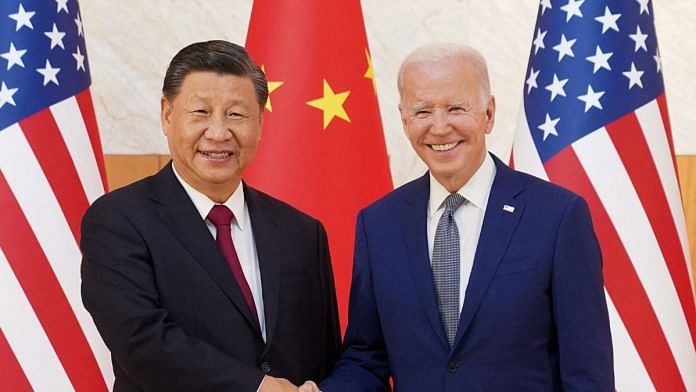ChatGPT’s success may have given the impression that the United States is squarely ahead of China in the Artificial Intelligence race, but that’s not entirely correct. The AI revolution in China’s automotive, manufacturing, healthcare, and life sciences sectors is creating a footprint that can help Beijing stay in the AI race.
While Chinese companies are struggling to develop Large Language Models (LLMs) to mimic the success of OpenAI’s ChatGPT programme, it doesn’t mean that the US now dominates all domains of AI competition; Chinese companies continue to push the boundaries of innovation.
Management consulting firm Mckinsey estimates that the implementation of AI technology in China’s automotive, transportation, and logistics arenas can generate upwards of $380 billion in economic value, as the country expects to see 300 million passenger vehicles on its roads by 2030.
Chinese company BYD Auto is pushing the electric car revolution, the second stage of its business being to innovate AI technology for cars. The most significant AI growth will be driven by autonomous vehicles – a value creation of $335 billion – including smart cars.
In 2022, China surpassed Germany to become the world’s second-largest car exporter after the former experienced a 54.4 per cent surge in its annual automobile exports. This spike was primarily driven by the export of BYD EVs, which can now even be seen on the streets of Uzbekistan and other Central Asian countries.
How China tackles US restrictions
A major hurdle for Chinese companies is the US’ CHIPS and Science Act, which aims to cut the former’s semiconductor access while boosting American domestic manufacturing and supply chains.
In fact, it isn’t trying to completely choke Chinese semiconductor companies but rather restricting their access to most cutting-edge chips. President Joe Biden’s administration doesn’t want Beijing to ditch US semiconductors altogether, instead pushing to expand its home-grown chip base.
Despite the restrictions, American software company Nvidia has found ways to supply semiconductor chips to Chinese companies – by slowing down their speed to stay in line with US rules. Nvidia’s H800 chip, announced in March and allowed for export to China, will likely take 10 to 30 per cent longer to carry out AI tasks. However, even the slowed-down Nvidia H800 is an improvement for Chinese companies. For instance, as per a Reuters report, it will allow Chinese tech giant Tencent to significantly reduce the time it takes to train its largest AI system – by more than half.
Moreover, Chinese AI companies are tackling the slow chip problem by buying more such chips and feeding them data for improving their language models.
Also read: Modi’s US visit is everything China hates. It even called Biden’s optimism ‘wishful thinking’
Beijing is still treading ahead
Clearly, China has its strengths in the AI race.
According to the Australian Strategic Policy Institute (ASPI)’s Critical Technology Tracker, China has beaten the US to emerge as a leader in advanced data analytics, which is crucial to driving insights from vast amounts of data.
Except for Natural Language Processing – which enables computers to understand and interpret human languages – China competes quite well with the US in the 11 domains of AI research – even beating the US in some areas, according to the ASPI tracker.
At first, China was likely to fail while developing its own ChatGPT-like model because of limits to the quality of data available to domestic companies and the censorship imposed by its government. But we can’t assume that the US has wholly beaten China as universities in the mainland continue to publish cutting-edge research with potential for application.
Chinese institutions such as Huazhong University of Science and Technology, the Harbin Institute of Technology and the Chinese Academy of Science are consistently in the top 10 list of AI-related research publications in all domains. Only one or two US universities have achieved the same feat, and that too in some domains.
According to a new report by the US-based Center for Strategic and Budgetary Assessments, China still can establish its leadership in 5G, AI, quantum technology, cybersecurity, clean energy, and biotechnology, despite US leadership in defence-related emerging technology.
On Tuesday, Chinese search engine Baidu announced that its new Ernie Bot beats ChatGPT when tested for Chinese language proficiency and other benchmarks. The results of Ernie Bot’s relative success against ChatGPT were based on tests done by China Science Daily Journal, marking an improvement in creative writing, Q&A, reasoning and code generation.
Ernie Bot’s relative success shows that China can significantly influence emerging technologies and their impact on society – just by closely trailing the US.
AI even featured prominently during Narendra Modi’s recent US visit, and when OpenAI’s Sam Altman met the Indian Prime Minister during his recent trip to New Delhi. India hopes to collaborate with the US on AI technology through the $2 million US-India Science and Technology Endowment fund, except that the US’ leadership in AI isn’t completely secure. The proliferation of China-driven AI technology will likely pose unique geopolitical and geoeconomic challenges for India.
Writing off China in the AI race would surely amount to folly.
The author is a columnist and a freelance journalist. He was previously a China media journalist at the BBC World Service. He is currently a MOFA Taiwan Fellow based in Taipei and tweets @aadilbrar. Views are personal.
(Edited by Zoya Bhatti)



